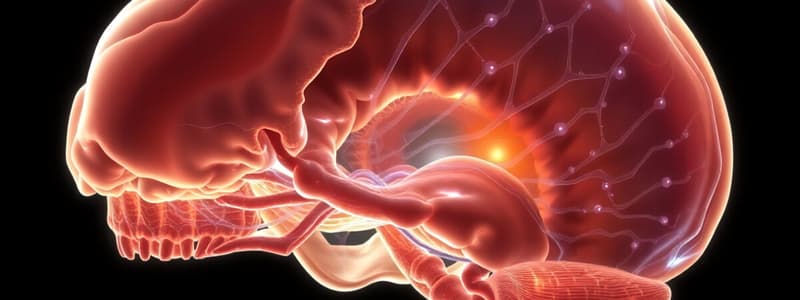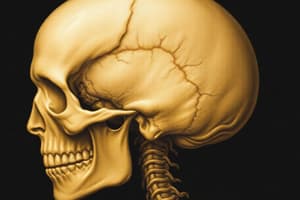Podcast
Questions and Answers
Which of the following structures is NOT primarily derived from the paraxial mesoderm in the head region?
Which of the following structures is NOT primarily derived from the paraxial mesoderm in the head region?
- Membranous components of the neurocranium
- Dermis of the dorsal head region
- Voluntary muscles of the craniofacial region
- Laryngeal cartilages (arytenoid and cricoid) (correct)
Neural crest cells contribute to a wide array of tissues in the head region. Which of the following is NOT a derivative of neural crest cells in this location?
Neural crest cells contribute to a wide array of tissues in the head region. Which of the following is NOT a derivative of neural crest cells in this location?
- Dentin
- Laryngeal Cartilages (correct)
- Sensory neurons
- Pia and arachnoid
Ectodermal placodes contribute to the formation of specific structures in the head region. Which of the following is formed by the ectodermal placodes?
Ectodermal placodes contribute to the formation of specific structures in the head region. Which of the following is formed by the ectodermal placodes?
- Bones of the Viscerocranium
- Voluntary muscles of facial expression
- Meninges caudal to the prosencephalon
- Neurons of the 5th, 7th, 9th, and 10th cranial sensory ganglia (correct)
Considering the contributions of different mesodermal sources to the head region, if the lateral plate mesoderm was disrupted during development, which structure would be most affected?
Considering the contributions of different mesodermal sources to the head region, if the lateral plate mesoderm was disrupted during development, which structure would be most affected?
A defect in neural crest cell migration to the facial region would most likely result in malformation of which of the following structures?
A defect in neural crest cell migration to the facial region would most likely result in malformation of which of the following structures?
Flashcards
Origin of Head Mesenchyme
Origin of Head Mesenchyme
Mesenchyme in the head comes from paraxial and lateral plate mesoderm, neural crest, and ectodermal placodes.
Paraxial Mesoderm Derivatives
Paraxial Mesoderm Derivatives
Forms neurocranium components, craniofacial muscles, dermis, connective tissues, and meninges caudal to the prosencephalon.
Lateral Plate Mesoderm Derivatives
Lateral Plate Mesoderm Derivatives
Forms laryngeal cartilages and connective tissue in the laryngeal region.
Neural Crest Cell Derivatives
Neural Crest Cell Derivatives
Signup and view all the flashcards
Ectodermal Placode Function
Ectodermal Placode Function
Signup and view all the flashcards
Study Notes
- Mesenchyme for head formation comes from paraxial mesoderm, lateral plate mesoderm, neural crest, and ectodermal placodes.
- Paraxial mesoderm creates much of the membranous and cartilaginous neurocranium (skull).
- It also forms voluntary craniofacial muscles, dermis, connective tissues in the dorsal head, and meninges caudal to the prosencephalon.
- Lateral plate mesoderm forms laryngeal cartilages and connective tissue in that area.
- Neural crest cells from the neuroectoderm migrate ventrally into the pharyngeal arches and rostrally around the forebrain and optic cup.
- They form the entire viscerocranium (face) and parts of the neurocranium (skull).
- Neural crest cells also form cartilage, bone, dentin, tendon, dermis, pia and arachnoid, sensory neurons, and glandular connective tissue.
- Ectodermal placodes (epipharyngeal placodes), along with neural crest, form neurons of the 5th, 7th, 9th, and 10th cranial sensory ganglia.
Studying That Suits You
Use AI to generate personalized quizzes and flashcards to suit your learning preferences.




